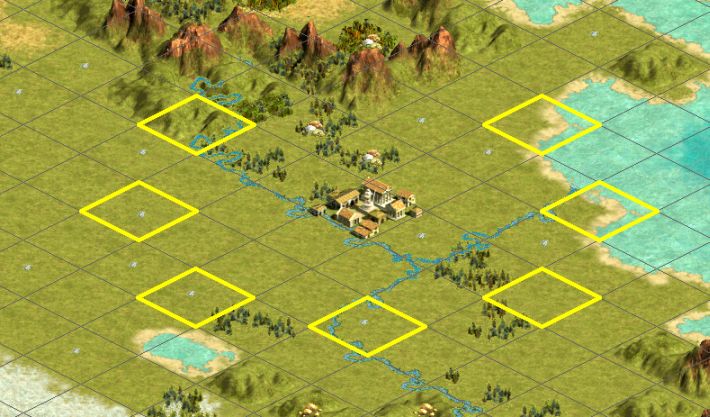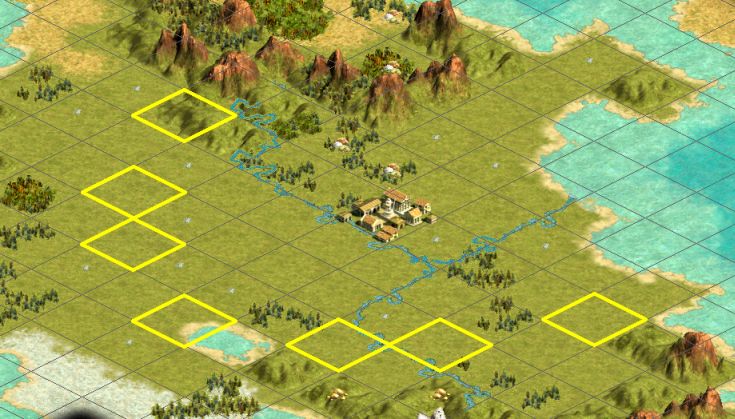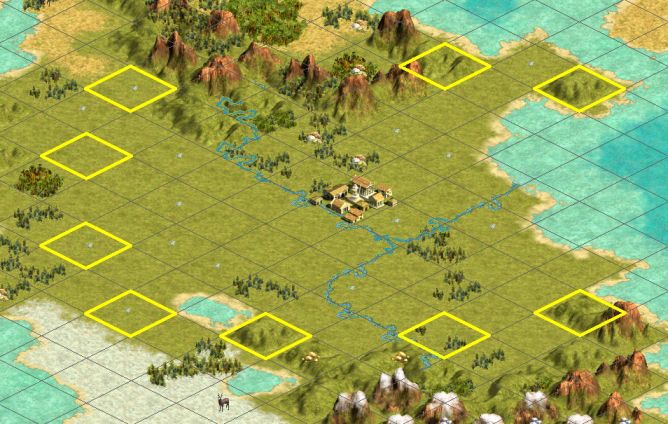DaviddesJ
Deity
Ring City Placement (RCP) is a new approach to city placement in your empire. Other placement strategies, like OCP, are based on land use patterns. RCP is based on a different principle: reducing corruption.
Thanks to alexman and this thread Do you think you understand corruption?, we know that corruption has two sources: corruption due to the distance from the capital or forbidden palace, and corruption due to the number of cities.
There is a natural tension between these two: you can achieve low corruption of the first kind by placing many cities very close to your capital (a la ICS), but this means that if you want to exploit all of your land, you need a lot of cities, and the corruption of the second kind is severe. On the other hand, if you try to work all of your land with relatively few cities, to minimize corruption of the second kind, then the cities are spread out and far away.
Alexman discovered that corruption of the second kind depends on the number of cities that are closer to your capital or forbidden palace than a given city. When I read this, after a while, a question occurred to me: what happens if two cities are at the same distance from the capital or FP? This called for some tests, but the answer is that only cities that are closer count for corruption purposes; cities at the same distance don't increase corruption in other cities at that distance.
There's a way to take advantage of this: build several cities at exactly the same distance from the capital. I call this Ring City Placement, because the cities at the same distance form a "ring" on the map.
It's important to understand how the rings work, which has been explained in detail in the alexman thread.
This method of calculation is unintuitive at first, but with practice, it becomes easy to "see" the rings at a given distance. The Firaxis distance is always an integer, or half an integer, so there are many more city sites at the "same distance" than you might first expect. For example, there are 8 city sites at distance 3 from the capital (but some of these might be unbuildable mountains or water, of course).
[TODO: insert illustration of rings and distance calculation]
Here's a chart for various distances, of how many sites are at that distance, and how many cities can potentially be built at that distance. (Sometimes two sites at the same distance are adjacent, so only one of the two can be built.)
As should be clear, RCP is not a single fixed rule governing the exact locations of cities. The player can choose the distance of the rings, and also to decide whether to build on some or all of the potential city sites in each ring.
One natural approach is to build an "inner ring" at distance 3-4, and another "outer ring" at distance 6-9. I call this 2RCP, because there are two rings. You get several inner cities with extremely low corruption (often around 10% or less), and a whole lot of outer cities with manageable corruption (well under 50%).
But there are other alternatives. You might build on some but not all of the sites in the inner ring, in order to reduce corruption in the outer ring (because each inner ring city increases corruption in every outer ring city). (Call this 1.5RCP.) Or you might decide not to build an inner ring at all, and just build a single outer ring of cities at distance 6-9, which could have as many as 20 cities with as little as 20% corruption in all of them. (Call this alternative 1RCP.) You might also make different choices at different points in the game: you could start the game with an inner ring, but once the outer ring is fully developed, abandon some or all of the cities in the inner ring.
There are also a lot of open questions, like how to combine RCP with Forbidden Palace placement, or with a Palace Jump. Clearly you can build one set of rings around your Palace and another set of rings around your Forbidden Palace, but they have to be far apart, or else the rings will interfere with each other. Are there other ways to use the Palace and FP? I'm not sure. I'm definitely still learning, myself. I also know that some people have already been experimenting with RCP, since I mentioned it in the GOTM20 Spoiler #1 thread, and I hope they will post their observations here, for a larger audience. I'm personally applying the RCP idea in GOTM20, and I hope to post detailed illustrations and examples from that game, once the GOTM period is over. (But first I have to finish!)
I do want to especially congratulate alexman for all of his work on corruption, because if he hadn't worked out the basic mechanisms, I never would have had the idea for RCP. I also really look forward to other players finding ways to use the RCP idea, which I may not have thought of, and I hope they will share those in this thread.
Thanks to alexman and this thread Do you think you understand corruption?, we know that corruption has two sources: corruption due to the distance from the capital or forbidden palace, and corruption due to the number of cities.
There is a natural tension between these two: you can achieve low corruption of the first kind by placing many cities very close to your capital (a la ICS), but this means that if you want to exploit all of your land, you need a lot of cities, and the corruption of the second kind is severe. On the other hand, if you try to work all of your land with relatively few cities, to minimize corruption of the second kind, then the cities are spread out and far away.
Alexman discovered that corruption of the second kind depends on the number of cities that are closer to your capital or forbidden palace than a given city. When I read this, after a while, a question occurred to me: what happens if two cities are at the same distance from the capital or FP? This called for some tests, but the answer is that only cities that are closer count for corruption purposes; cities at the same distance don't increase corruption in other cities at that distance.
There's a way to take advantage of this: build several cities at exactly the same distance from the capital. I call this Ring City Placement, because the cities at the same distance form a "ring" on the map.
It's important to understand how the rings work, which has been explained in detail in the alexman thread.
Corruption calculations do not use Euclidean geometry, nor unit movement points, to get distance. Instead, the distance is based on the shortest path, where each orthogonal move costs 1.0 and each diagonal move costs 1.5. Another way of writing the distance formula is Distance = max(x,y) + 0.5*min(x,y), where x and y are the distance in the NW/SE and NE/SW directions, respectively.
This method of calculation is unintuitive at first, but with practice, it becomes easy to "see" the rings at a given distance. The Firaxis distance is always an integer, or half an integer, so there are many more city sites at the "same distance" than you might first expect. For example, there are 8 city sites at distance 3 from the capital (but some of these might be unbuildable mountains or water, of course).
[TODO: insert illustration of rings and distance calculation]
Here's a chart for various distances, of how many sites are at that distance, and how many cities can potentially be built at that distance. (Sometimes two sites at the same distance are adjacent, so only one of the two can be built.)
Code:
Distance Sites Cities
2.0 4 4
2.5 8 4
3.0 8 8
3.5 8 8
4.0 12 8
4.5 12 12
5.0 12 12
5.5 16 12
6.0 16 16
6.5 16 16
7.0 20 16
7.5 20 20
8.0 20 20
8.5 24 20
9.0 24 24
9.5 24 24
10.0 28 24
etc.As should be clear, RCP is not a single fixed rule governing the exact locations of cities. The player can choose the distance of the rings, and also to decide whether to build on some or all of the potential city sites in each ring.
One natural approach is to build an "inner ring" at distance 3-4, and another "outer ring" at distance 6-9. I call this 2RCP, because there are two rings. You get several inner cities with extremely low corruption (often around 10% or less), and a whole lot of outer cities with manageable corruption (well under 50%).
But there are other alternatives. You might build on some but not all of the sites in the inner ring, in order to reduce corruption in the outer ring (because each inner ring city increases corruption in every outer ring city). (Call this 1.5RCP.) Or you might decide not to build an inner ring at all, and just build a single outer ring of cities at distance 6-9, which could have as many as 20 cities with as little as 20% corruption in all of them. (Call this alternative 1RCP.) You might also make different choices at different points in the game: you could start the game with an inner ring, but once the outer ring is fully developed, abandon some or all of the cities in the inner ring.
There are also a lot of open questions, like how to combine RCP with Forbidden Palace placement, or with a Palace Jump. Clearly you can build one set of rings around your Palace and another set of rings around your Forbidden Palace, but they have to be far apart, or else the rings will interfere with each other. Are there other ways to use the Palace and FP? I'm not sure. I'm definitely still learning, myself. I also know that some people have already been experimenting with RCP, since I mentioned it in the GOTM20 Spoiler #1 thread, and I hope they will post their observations here, for a larger audience. I'm personally applying the RCP idea in GOTM20, and I hope to post detailed illustrations and examples from that game, once the GOTM period is over. (But first I have to finish!)
I do want to especially congratulate alexman for all of his work on corruption, because if he hadn't worked out the basic mechanisms, I never would have had the idea for RCP. I also really look forward to other players finding ways to use the RCP idea, which I may not have thought of, and I hope they will share those in this thread.

 Do you have a sample screenshot of your RCP?
Do you have a sample screenshot of your RCP?






 But I have a feeling the other factors in city placement (f/s/c values of the surrounding terrain, being on coasts instead of one tile away, being on rivers, taking advantage of the AI borders, not bothering reposistioning captured cities, etc.) might top corruption and waste in importanace. I guess I'll have to wait and see until GOTM 20 is over. I can't wait!
But I have a feeling the other factors in city placement (f/s/c values of the surrounding terrain, being on coasts instead of one tile away, being on rivers, taking advantage of the AI borders, not bothering reposistioning captured cities, etc.) might top corruption and waste in importanace. I guess I'll have to wait and see until GOTM 20 is over. I can't wait! 